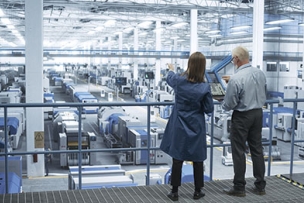These are six minimum protective measures that you’ll want to take to stay compliant with the OSHA machine guarding standard:
-
Prevent contact with dangerous moving parts.
-
Secure guards to prevent tampering and to withstand normal wear.
-
Ensure guards prevent falling objects from coming into contact with moving parts.
-
Avoid creating any new hazards by adding the guards.
-
Check that guards create no interference to machine use.
-
Allow for lubrication without removing the guards.
And don’t think that you’ll get away with this violation, because it will be easy for OSHA inspectors to spot, de Leon notes: The guards simply aren’t there.
Often there are machines sitting on shop floors, particularly older machines, that have no guards whatsoever, he says. In reality, it matters little whether a machine is old or new, the shop must take the lead in ensuring guards are in place and adjusted properly, de Leon says.
“Even when a machine includes adequate machine guards that meet OSHA’s regulatory requirements, those guards must be continually adjusted and inspected to ensure they maintain compliance,” explains a post on the Southern Metal Fabricators blog. “Again, that responsibility falls on the purchaser.”
As OSHA guidance notes, it’s necessary to uniquely craft and fit a guard. To that end, there are many guards and kits available to provide the ideal protection for the specific machine, job and user.
3 Machine Guarding Tips for Your Shop
“Each year, thousands of workers lose a limb in situations that are largely preventable,” points out risk control consultant Nick Rosseter.
Here are three things you can do to keep workers safe and avoid a costly OSHA fine.
Machine Guarding Tip 1: Educate Yourself and Your Workers (for Free)
A chief culprit is lack of awareness and training, de Leon says. Often, he finds that businesses simply do not know what is required.
When he finds the need is educational, de Leon often recommends that metalworking and manufacturing shops tap into free OSHA consultation services.
“Call OSHA yourself and have them help you become compliant,” de Leon says. “If you call them, they will come and do a survey and help you get your shop in compliance.”





Talk to Us!
how do you safe guard a 90 degree die grinder, when the tool is sold for the purpose of getting into tight spaces or areas, and comes without a guard.
will OSHA still fine us?
25The general rule is that all grinders require a guard. There are exceptions to the rule. Die Grinder tools (AKA Rotary file tools) are listed as one of the exceptions.
OSHA states the exception in CFR 1910.243(c) “Mounted wheels used in portable operations 2 inches and smaller in diameter…”
Please let us know the manufacturer and model number of your die grinder and we can advise on the proper guard.
26This is a very informative blog, thanks for sharing about safety osha machine guarding checklist retrofit and customize your guards. I liked and it is wonderful to know about so many things that are useful for all of us! Thanks a lot for this amazing blog!!
26I was looking for this information relating to osha machine guarding checklist retrofit and customize your guards . You have really eased my work by posting this article, loved your writing skill as well. Please keep sharing more, would love to read more from you!
for more info:-https://www.lyonauction.com/
22As a previous OSHA compliance officer and consultant, and now a privated EH&S Consultant; "Machine Guarding" has always and will continue to be a priority in my guidance; but there is something you, the employer needs to understand, a "truth" that even OSHA and other professionals hate to admit. The "Truth": All machine guards, even the mandated ones "Don't Protect The Operator"! What? Let me give you just two examples:
1. Radial Saw: 29 CFR 1910.213.(h)(1):.......The sides of the lower exposed portion of the blade shall be guarded to the full diameter of the blade by a device that will automatically adjust itself to the thickness of the stock and remain in contact with stock being cut to give maximum protection possible for the operation being performed.
What the above "required" guard does is simply make the saw operator aware that they are close to the "blade" when feeding stock from the side portion of the saw "point of operation" (cutting blade). It DOES NOT PROTECT the operator from inadvertantly having their finger on the stock, in the direction of the blade, thus the injury. It is an "Ineffective Guard", but "accepted" by OSHA.
2. Band Saw: 1910.213(i)(1)
All portions of the saw blade shall be enclosed or guarded, except for the working portion of the blade between the bottom of the guide rolls and the table.
Once again, all portions of the "unused blade" must be guarded, BUT, the portion cutting, the "Point of Operation" is, and must be completely "exposed". If the operator is not paying attention, the risk of an injury exist due to the (allowed) "exsposed" blade.
The myth that goes like this: A guard as defined by OSHA is an enclosure that prevents anyone from reaching over, under, around, or through, and offers the highest level of protection.
As the two examples have shown: Even "OSHA Accepted" (mandated) guards DO NOT meet that definition.
Summary: There are "acceptable" risk when it comes to "Machine Guarding", when these are encountered, it is the "Operator Training" that provides the "Best Machine Guarding"
9I work for a national company and need a large number of guards manufactured in Fort Lauderdale and Pompano. Can you recommend someone?
2Leave a reply
Your email address will not be published. Required fields are marked *